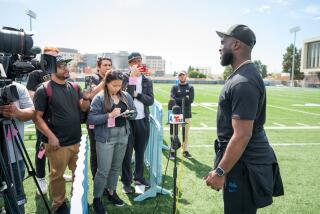With Credit Suisse Acquisition, Future of DLJ’s Los Angeles Office Is Debated
- Share via
The takeover of investment banking giant Donaldson Lufkin & Jenrette Inc., a deal sealed Wednesday, could mean a major shake-up of the financial landscape in Los Angeles, where DLJ has been the region’s dominant investment banking presence for the last decade.
Though the $11.5-billion merger with Credit Suisse First Boston could eventually create a global powerhouse, some rival Wall Street firms are questioning whether the large Los Angeles DLJ staff, led by Ken Moelis, can keep its prized autonomy--and whether many of the firm’s well-connected deal makers will opt to stay put in any case.
Los Angeles holds one of the jewels that attracted Swiss banking giant Credit Suisse Group, parent of Credit Suisse First Boston, to DLJ in the first place, analysts say: a major investment banking and junk-bond underwriting practice.
The group of more than 120 bankers in Century City is led by Moelis, arguably the most powerful investment banker in Los Angeles, and boasts such clients as Donald Trump, corporate raider Carl Icahn and grocery magnate Ron Burkle.
Moelis helped expand the DLJ office after leaving Drexel Burnham Lambert to join DLJ with a team of other bankers about 10 years ago.
But amid expectations of global staff cutbacks with the DLJ-CSFB merger, a key question is what happens to the Los Angeles DLJ office.
“It’s up to us to keep our people, and I think we will,” said Moelis, 42, reached on vacation in the Canadian Rockies. “Our clients are thrilled. I’ve talked to people today and they think it’s phenomenal. Our competitors must be terrified to see this new global competitor that’s popped up.”
Some rivals see things differently. “We had viewed DLJ as a significant competitor here, but the consolidation, in the short run, presents significant opportunity for us on the West Coast,” said Will Mesdag, managing director at Goldman, Sachs & Co. and head of the Los Angeles office, which has 30 bankers.
Mesdag and others speculated that bankers from both DLJ and CSFB might bolt, despite big bonuses aimed at retaining them. Clients could then be wooed away as well. Some bankers said top DLJ names could start their own firms.
Unlike most Wall Street investment banks that thrive on central control and keep regional offices on a short leash, DLJ has let its corporate finance group here operate with great autonomy from the firm’s New York headquarters.
Meanwhile, Credit Suisse First Boston, which has its corporate finance unit based in New York, has struggled to expand its Western headquarters, based in Los Angeles and headed by Mark Maron. The firm has about 30 bankers and analysts in Westwood.
Bankers said it was unclear Wednesday how the two offices might be merged and speculated that DLJ’s bankers here might chafe under CSFB control.
“People are still struggling with what this all means,” said Peter J. Nolan, a former co-head of the DLJ office in Los Angeles, who is now with buyout firm Leonard Green & Partners. “But investment banks have a history of centralized control. You see it time and time again; they just don’t want regional offices getting too powerful. DLJ was an aberration.”
At CSFB, Maron conceded that he as yet has “no idea what it will mean in L.A., though I would guess we will find ourselves moving in with Kenny’s crew.”
Moelis praised Maron and CSFB in Los Angeles for keeping together a group of experienced bankers, some of whom he said he has tried to hire in recent years.
Moelis said he wasn’t concerned about CSFB control issues, saying the firm has allowed its Palo Alto-based technology division of 500 bankers to operate with a significant level of autonomy. “With tech, they’ve shown an ability not to micro-manage,” he said.
In recent years DLJ’s local team has increasingly been involved in raising equity for growing companies, although it has also continued to structure a major share of the nation’s junk-bond deals. DLJ remains the top U.S. underwriter of junk bonds; CSFB is much larger in terms of overall investment banking.
Many of the Los Angeles DLJ bankers, like Moelis, are formerly from Drexel, with significant expertise in junk bonds and takeovers. But the office in recent years has shifted with the economy to focus on tech and telecom. It gets a large chunk of its revenue from advising tech, media and telecom companies on financial matters, including selling high-yield bonds for such firms.
CSFB in Los Angeles, by contrast, has made its money working with “old-economy”-type firms. Maron is part of a team that put together some large bank mergers, such as the $9.9-billion sale of H.F. Ahmanson to Washington Mutual.
Much of CSFB’s strength on the West Coast is in Palo Alto, where financier Frank Quattrone leads the huge team of investment bankers in the firm’s tech division.
Though DLJ and CSFB have many areas that overlap, on the West Coast it’s in the area of technology investment banking--with its lucrative fees from initial public stock offerings--where the question of executive supremacy is key.
It’s unclear how Quattrone and Moelis might work out their responsibilities, and spokesmen for the two firms said they could not comment.
“They’ve got some talented bankers in Los Angeles. We’re going to bring these guys in and work on some relationships,” said John Hodges, head of CSFB’s corporate finance for tech firms. “Ken, specifically, has built a great business.”
But Quattrone’s people “are very aggressive and their behavior is not the most team-like,” said one Los Angeles banker, who didn’t want to be named. “I can’t see the DLJ guys coming out in good shape.”
Moelis disagreed, saying the two firms are very complementary and that his office’s emphasis on the growing Southland tech scene will fit right into Quattrone’s business.
*
* FAKED OUT?
Owners of DLJ’s online brokerage shares won’t get merger payoff. C4
More to Read
Inside the business of entertainment
The Wide Shot brings you news, analysis and insights on everything from streaming wars to production — and what it all means for the future.
You may occasionally receive promotional content from the Los Angeles Times.










